Sequence, distance, and accessibility are determinants of 5'-end-directed cleavages by retroviral RNases H
- PMID: 16306040
- PMCID: PMC1360142
- DOI: 10.1074/jbc.M510504200
Sequence, distance, and accessibility are determinants of 5'-end-directed cleavages by retroviral RNases H
Abstract
The RNase H activity of reverse transcriptase is essential for retroviral replication. RNA 5'-end-directed cleavages represent a form of RNase H activity that is carried out on RNA/DNA hybrids that contain a recessed RNA 5'-end. Previously, the distance from the RNA 5'-end has been considered the primary determinant for the location of these cleavages. Employing model hybrid substrates and the HIV-1 and Moloney murine leukemia virus reverse transcriptases, we demonstrate that cleavage sites correlate with specific sequences and that the distance from the RNA 5'-end determines the extent of cleavage. An alignment of sequences flanking multiple RNA 5'-end-directed cleavage sites reveals that both enzymes strongly prefer A or U at the +1 position and C or G at the -2 position, and additionally for HIV-1, A is disfavored at the -4 position. For both enzymes, 5'-end-directed cleavages occurred when sites were positioned between the 13th and 20th nucleotides from the RNA 5'-end, a distance termed the cleavage window. In examining the importance of accessibility to the RNA 5'-end, it was found that the extent of 5'-end-directed cleavages observed in substrates containing a free recessed RNA 5'-end was most comparable to substrates with a gap of two or three bases between the upstream and downstream RNAs. Together these finding demonstrate that the selection of 5'-end-directed cleavage sites by retroviral RNases H results from a combination of nucleotide sequence, permissible distance, and accessibility to the RNA 5'-end.
Figures

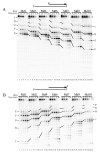
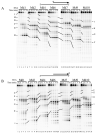

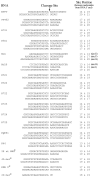
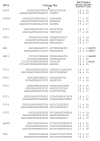
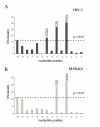


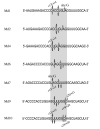
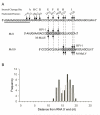
Similar articles
-
Preferred sequences within a defined cleavage window specify DNA 3' end-directed cleavages by retroviral RNases H.J Biol Chem. 2009 Nov 20;284(47):32225-38. doi: 10.1074/jbc.M109.043158. Epub 2009 Sep 24. J Biol Chem. 2009. PMID: 19778906 Free PMC article.
-
Recognition of internal cleavage sites by retroviral RNases H.J Mol Biol. 2004 Nov 26;344(3):635-52. doi: 10.1016/j.jmb.2004.09.081. J Mol Biol. 2004. PMID: 15533434
-
Multiple nucleotide preferences determine cleavage-site recognition by the HIV-1 and M-MuLV RNases H.J Mol Biol. 2010 Mar 19;397(1):161-78. doi: 10.1016/j.jmb.2010.01.059. Epub 2010 Feb 1. J Mol Biol. 2010. PMID: 20122939 Free PMC article.
-
RNase H activity: structure, specificity, and function in reverse transcription.Virus Res. 2008 Jun;134(1-2):86-103. doi: 10.1016/j.virusres.2007.12.007. Epub 2008 Feb 7. Virus Res. 2008. PMID: 18261820 Free PMC article. Review.
-
Ribonuclease H: properties, substrate specificity and roles in retroviral reverse transcription.FEBS J. 2009 Mar;276(6):1506-16. doi: 10.1111/j.1742-4658.2009.06909.x. Epub 2009 Feb 18. FEBS J. 2009. PMID: 19228195 Free PMC article. Review.
Cited by
-
HIV-1 Ribonuclease H: Structure, Catalytic Mechanism and Inhibitors.Viruses. 2010 Apr;2(4):900-926. doi: 10.3390/v2040900. Epub 2010 Mar 30. Viruses. 2010. PMID: 21994660 Free PMC article.
-
Effects of identity minimization on Moloney murine leukemia virus template recognition and frequent tertiary template-directed insertions during nonhomologous recombination.J Virol. 2007 Nov;81(22):12156-68. doi: 10.1128/JVI.01591-07. Epub 2007 Sep 5. J Virol. 2007. PMID: 17804514 Free PMC article.
-
Nucleocapsid Protein Precursors NCp9 and NCp15 Suppress ATP-Mediated Rescue of AZT-Terminated Primers by HIV-1 Reverse Transcriptase.Antimicrob Agents Chemother. 2020 Sep 21;64(10):e00958-20. doi: 10.1128/AAC.00958-20. Print 2020 Sep 21. Antimicrob Agents Chemother. 2020. PMID: 32747359 Free PMC article.
-
Retroviral RNase H: Structure, mechanism, and inhibition.Enzymes. 2021;50:227-247. doi: 10.1016/bs.enz.2021.07.007. Epub 2021 Sep 24. Enzymes. 2021. PMID: 34861939 Free PMC article. Review.
-
Mechanism analysis indicates that recombination events in HIV-1 initiate and complete over short distances, explaining why recombination frequencies are similar in different sections of the genome.J Mol Biol. 2009 Apr 24;388(1):30-47. doi: 10.1016/j.jmb.2009.02.029. Epub 2009 Feb 20. J Mol Biol. 2009. PMID: 19233203 Free PMC article.
References
-
- Arts EJ, LeGrice SFJ. Prog. Nucleic Acid Res. Mol. Biol. 1998;58:339–393. - PubMed
-
- Coffin JM, Hughes SH, Varmus HE. Retroviruses. Cold Spring Harbor Laboratory Press; Plainview, N. Y.: 1997. - PubMed
-
- di Marzo Veronese F, Copeland TD, DeVico AL, Rahman R, Oroszlan S, Gallo RC, Sarngadharan MG. Science. 1986;231:1289–1291. - PubMed
-
- Misra HS, Pandey PK, Pandey VN. J. Biol. Chem. 1998;273:9785–9789. - PubMed
Publication types
MeSH terms
Substances
Grants and funding
LinkOut - more resources
Full Text Sources
Other Literature Sources
Miscellaneous

